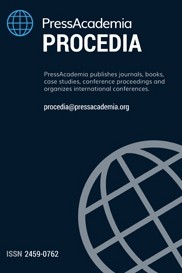EXAMINING THE CONCEPT OF OCCUPATIONAL BURNOUT AND THE LEVEL OF OCCUPATIONAL BURNOUT IN TERMS OF DEMOGRAPHIC VARIABLES
EXAMINING THE CONCEPT OF OCCUPATIONAL BURNOUT AND THE LEVEL OF OCCUPATIONAL BURNOUT IN TERMS OF DEMOGRAPHIC VARIABLES
Occupational burnout, demographic variables, feelings of emotional exhaustion depersonalization and decreased personal achievement,
___
- Örmen, U. (1993). Tükenmişlik Duygusu ve Yöneticiler Üzerinde Bir Uygulama (Doctoral Dissertation, Marmara Universitesi (Turkey)).
- Wright, T. A., & Bonett, D. G. (1997). The contribution of burnout to work performance. Journal Of Organizational Behavior, 18(5), 491-499.
- Özel, S. (2016). Farklı Liselerde Görev Yapan Yönetici Ve Öğretmenlerin İş Doyumlarına İlişkin Algıları Ve Tükenmişlik Düzeyleri Arasındaki İlişki Tekirdağ/Çerkezköy Örneği (Master's Thesis, İstanbul Sabahattin Zaim Üniversitesi, Sosyal Bilimler Enstitüsü, Eğitim Bilimleri Anabilim Dalı).
- Otacıoğlu, S. G. (2008). Müzik öğretmenlerinde tükenmişlik sendromu ve etkileyen faktörler. İnönü Üniversitesi Eğitim Fakültesi Dergisi, 9(15), 103-116.
- Cemaloğlu, N., & Şahin, D. E. (2007). Öğretmenlerin mesleki tükenmişlik düzeylerinin farkli değişkenlere göre incelenmesi. Kastamonu Eğitim Dergisi, 15(2), 463-484.
- Chesnutt, W. J. (1997). The relationship between social support and professional burnout among public secondary school teachers in Northeast Tennessee. Dissertation Abstract International, 52(6), 2070.
- Casserley, T. & Megginson, D., (2009). Learning From Burnout: Developing Sustainable Leaders And Avoiding Career Derailment. London:Routhledge.
- Şengün, C. (2021). Dijital Tükenmişlik: Başa Çıkmak İçin 5 Yöntem. Https://Www.Themagger.Com/Dijitaltukenmislik-Basa-Cikma-Yontemleri/
- Duodecim,2015.Http://Www.Terveyskirjasto.Fi/Terveyskirjasto/Tk.Koti?P_Artikkeli= Dlk00681 Accessed 04.03.2016.
- Shadid, A., Almutairi, F., Almotairi, K., Aldarwish, T., &Amp; Alzamil, O. (2020). Stress, burnout, and associated risk factors in medical students. Cureus, 12, 301-320.
- Lundgren-Nilsson, A., Jonsdottir, I., Pallant, J., Ahlborg, G. (2012). Internal Construct Validity Of The Shirom-Melamed Burnout Questionnaire. Doi: 10.1186/1471-2458-12-1
- Başlangıç: 2015
- Yayıncı: PressAcademia
A BIBLIOMETRİC ANALYSIS OF SPORTS MARKETING RESEARCH IN COMMUNICATION
GELİŞMİŞ VE YÜKSELEN PİYASA EKONOMİLERİNDE EKONOMİK İSTİHBARATIN TASARIMI MUKAYESELİ STATİK ANALİZ
Nazım EKREN, Muhammed Ali CINAR
İŞLETME SERMAYESİ YÖNETİMİNİN FİRMA PERFORMANSINA ETKİSİ
Salih CEREN YILDIRIM, Tülay ÖZKAN
E-İHRACATTA YAPAY ZEKA UYGULAMALARI: TÜRKİYE ANALİZİ
A LITERATURE REVIEW ON SOCIAL MEDIA IN FINANCE
ZERO WASTE AND CONSUMERS: A THEMATIC ANALYSIS OF REDDIT R/ZEROWASTE COMMUNITY POSTS
DOES PUBLIC DEBT IMPEDE FINANCIAL DEVELOPMENT IN JORDAN? SOME MACRO AND MICRO ANALYSES
